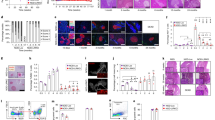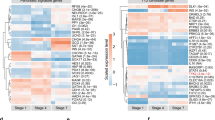Abstract
Type-I diabetes is a chronic disease mediated by autoimmune destruction of insulin-producing β-cells. Although progress has been made towards improving diabetes-associated pathologies and the quality of life for those living with diabetes, no therapy has been effective at eliminating disease manifestations or reversing disease progression. Here, we examined whether double-stranded adeno-associated virus serotype 8 (dsAAV8)-mediated gene delivery to endogenous β-cells of interleukin (IL)-4 in combination with β-cell growth factors can reverse early-onset diabetes in NOD mice. Our results demonstrate that a single treatment with dsAAV8 vectors expressing IL-4 in combination with glucagon-like peptide-1 or hepatocyte growth factor/NK1 under the regulation of the insulin promoter enhanced β-cell proliferation and survival in vivo, significantly delaying diabetes progression in NOD mice, and reversing disease in ∼10% of treated NOD mice. These results demonstrate the ability to reverse hyperglycemia in NOD mice with established diabetes by in vivo gene transfer to β-cells of immunomodulatory factors and β-cell growth factors.
This is a preview of subscription content, access via your institution
Access options
Subscribe to this journal
Receive 12 print issues and online access
$259.00 per year
only $21.58 per issue
Buy this article
- Purchase on Springer Link
- Instant access to full article PDF
Prices may be subject to local taxes which are calculated during checkout





Similar content being viewed by others
References
Rehman KK, Trucco M, Wang Z, Xiao X, Robbins PD . AAV8-mediated gene transfer of interleukin-4 to endogenous beta-cells prevents the onset of diabetes in NOD mice. Mol Ther 2008; 16: 1409–1416.
Riedel MJ, Gaddy DF, Asadi A, Robbins PD, Kieffer TJ . DsAAV8-mediated expression of glucagon-like peptide-1 in pancreatic beta-cells ameliorates streptozotocin-induced diabetes. Gene Therapy 2010; 17: 171–180.
Di Renzo MF, Poulsom R, Olivero M, Comoglio PM, Lemoine NR . Expression of the Met/hepatocyte growth factor receptor in human pancreatic cancer. Cancer Res 1995; 55: 1129–1138.
Natali PG, Nicotra MR, Di Renzo MF, Prat M, Bigotti A, Cavaliere R et al. Expression of the c-Met/HGF receptor in human melanocytic neoplasms: demonstration of the relationship to malignant melanoma tumour progression. Br J Cancer 1993; 68: 746–750.
Tuck AB, Park M, Sterns EE, Boag A, Elliott BE . Coexpression of hepatocyte growth factor and receptor (Met) in human breast carcinoma. Am J Pathol 1996; 148: 225–232.
Cioce V, Csaky KG, Chan AM, Bottaro DP, Taylor WG, Jensen R et al. Hepatocyte growth factor (HGF)/NK1 is a naturally occurring HGF/scatter factor variant with partial agonist/antagonist activity. J Biol Chem 1996; 271: 13110–13115.
Jakubczak JL, LaRochelle WJ, Merlino G . NK1, a natural splice variant of hepatocyte growth factor/scatter factor, is a partial agonist in vivo. Mol Cell Biol 1998; 18: 1275–1283.
Pediaditakis P, Monga SP, Mars WM, Michalopoulos GK . Differential mitogenic effects of single chain hepatocyte growth factor (HGF)/scatter factor and HGF/NK1 following cleavage by factor Xa. J Biol Chem 2002; 277: 14109–14115.
Gaddy DF, Riedel MJ, Pejawar-Gaddy S, Kieffer TJ, Robbins PD . In vivo expression of HGF/NK1 and GLP1 from dsAAV vectors enhances pancreatic beta cell proliferation and improves pathology in the db/db mouse model of diabetes. Diabetes 2010; 59: 3108–3116.
De León DD, Deng S, Madani R, Ahima RS, Drucker DJ, Stoffers DA . Role of endogenous glucagon-like peptide-1 in islet regeneration after partial pancreatectomy. Diabetes 2003; 52: 365–371.
Garcia-Ocaña A, Takane KK, Syed MA, Philbrick WM, Vasavada RC, Stewart AF . Hepatocyte growth factor overexpression in the islet of transgenic mice increases beta cell proliferation, enhances islet mass, and induces mild hypoglycemia. J Biol Chem 2000; 275: 1226–1232.
Pasquali L, Giannoukakis N, Trucco M . Induction of immune tolerance to facilitate beta cell regeneration in type 1 diabetes. Adv Drug Deliv Rev 2008; 60: 106–113.
Cameron MJ, Arreaza GA, Zucker P, Chensue SW, Strieter RM, Chakrabarti S et al. IL-4 prevents insulitis and insulin-dependent diabetes mellitus in nonobese diabetic mice by potentiation of regulatory T helper-2 cell function. J Immunol 1997; 159: 4686–4692.
Lee M, Koh JJ, Han SO, Ko KS, Ki SW . Prevention of autoimmune insulitis by delivery of interleukin-4 plasmid using a soluble and biodegradable polymeric carrier. Pharm Res 2002; 19: 246–249.
Wood SC, Rao TD, Frey AB . Multidose streptozotocin induction of diabetes in BALB/cBy mice induces a T cell proliferation defect in thymocytes which is reversible by interleukin-4. Cell Immunol 1999; 192: 1–12.
Zipris D, Karnieli E . A single treatment with IL-4 via retrovirally transduced lymphocytes partially protects against diabetes in BioBreeding (BB) rats. JOP 2002; 3: 76–82.
Liu Y . Hepatocyte growth factor and the kidney. Curr Opin Nephrol Hypertens 2002; 11: 23–30.
Zarnegar R, Michalopoulos GK . The many faces of hepatocyte growth factor: from hepatopoiesis to hematopoiesis. J Cell Biol 1995; 129: 1177–1180.
Wang Z, Zhu T, Rehman KK, Bertera S, Zhang J, Chen C et al. Widespread and stable pancreatic gene transfer by adeno-associated virus vectors via different routes. Diabetes 2006; 55: 875–884.
Dai C, Li Y, Yang J, Liu Y . Hepatocyte growth factor preserves beta cell mass and mitigates hyperglycemia in streptozotocin-induced diabetic mice. J Biol Chem 2003; 278: 27080–27087.
Gahr S, Merger M, Bollheimer LC, Hammerschmied CG, Scholmerich J, Hugl SR . Hepatocyte growth factor stimulates proliferation of pancreatic beta-cells particularly in the presence of subphysiological glucose concentrations. J Mol Endocrinol 2002; 28: 99–110.
Lokker NA, Godowski PJ . Generation and characterization of a competitive antagonist of human hepatocyte growth factor, HGF/NK1. J Biol Chem 1993; 268: 17145–17150.
Youles M, Holmes O, Petoukhov MV, Nessen MA, Stivala S, Svergun DI et al. Engineering the NK1 fragment of hepatocyte growth factor/scatter factor as a MET receptor antagonist. J Mol Biol 2008; 377: 616–622.
Xiao X, Li J, Samulski RJ . Production of high-titer recombinant adeno-associated virus vectors in the absence of helper adenovirus. J Virol 1998; 72: 2224–2232.
Acknowledgements
This study was supported by a program grant from the Juvenile Diabetes Research Foundation (JDRF) to PDR, and DFG was supported by a fellowship from the JDRF. MJR was supported by the Michael Smith Foundation for Health Research (MSFHR), the Canadian Diabetes Association, the Stem Cell Network and the JDRF. TJK is a MSFHR senior scholar. We thank Maliha Zahid (University of Pittsburgh) for assistance with statistical analysis and Joan Nash (University of Pittsburgh) for assistance with microscopy analysis.
Author information
Authors and Affiliations
Corresponding author
Ethics declarations
Competing interests
Dr Kieffer is a founder of Engene Inc., which is developing non-viral gene delivery methods to the gut for treatment of T1D. Dr Robbins is a member of the SAB for Engene.
Rights and permissions
About this article
Cite this article
Gaddy, D., Riedel, M., Bertera, S. et al. dsAAV8-mediated gene transfer and β-cell expression of IL-4 and β-cell growth factors are capable of reversing early-onset diabetes in NOD mice. Gene Ther 19, 791–799 (2012). https://doi.org/10.1038/gt.2011.181
Received:
Revised:
Accepted:
Published:
Issue Date:
DOI: https://doi.org/10.1038/gt.2011.181



